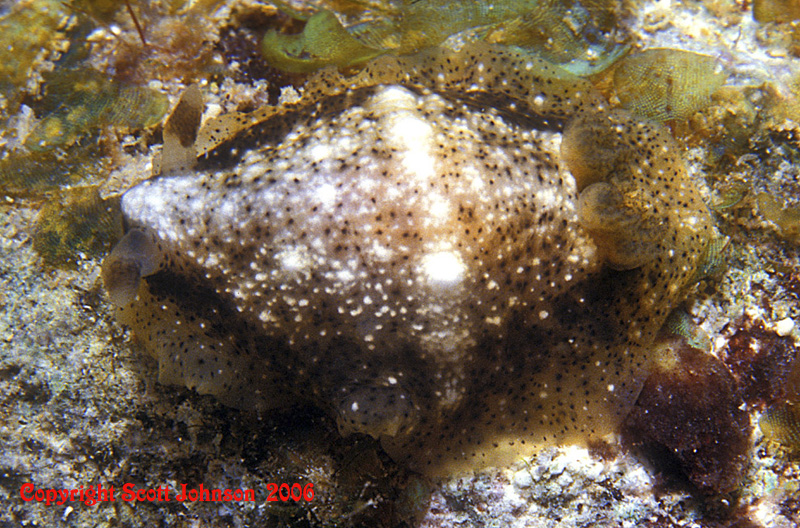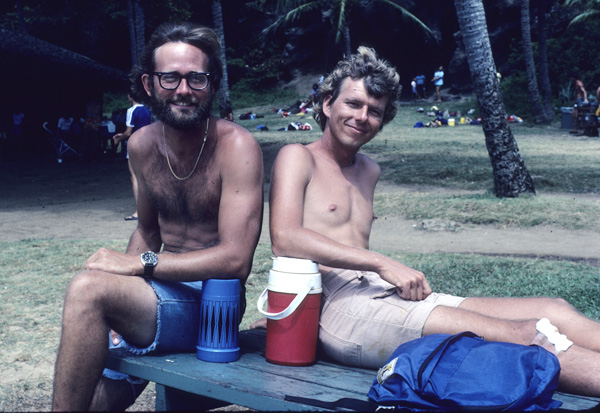 |
Dendrodoris coronata
Photo courtesy of Scott JohnsonEnewetak Atoll, under dead coral, 1.5m, L.Boucher
Dendrodoris coronata Kay & Young, 1969
We call it “The Bumpy-Crowned Dendrodorid,” a common name for an uncommon slug. This white/yellow, brownish-black splotched pustulate porostome had been recorded rarely from Kauai and Oahu, Hawaiian Islands (Kay & Young, 1969: p. 218; figs. 67, 70); Enewetak and Kwajalein, Marshall Islands (Johnson & Boucher, 1984); and Tab Island, Papua New Guinea (Valdés & Gosliner, 1999). Recently (May 2006) a video (5 meg Flash File) of a living Dendrodoris coronata, taken by John Greenamyer in Batangas, Philippine Islands, was posted on this site.
Several Internet sites report D. coronata from Koumac, New Caledonia (by Bill Rudman); ] Old Woman Island, the Sunshine Coast, Mooloolaba, Queensland, Australia (by Gary Cobb); ] New South Wales and the Great Barrier Reef, Australia by ( Bill Rudman ); ] Gahi Island, Kerama Islands, Okinawa (by Atsushi Ono) ; and Osezaki, NE side Izu Peninsula, Japan (by Tomohiko Kurihara).
Kay & Young's description (1969: 218) states: “Length, 8 to 30mm; width, 4 to 17 mm. The animal is broadly oval, wider posteriorly than anteriorly, soft, convex above, and the mantle margins are very thin and undulated. The mantle is transparent white, peppered with black and flaked with white; it is ornamented with numerous but irregular scattered pustules, those immediately anterior to the branchiae crownlike on a transverse raised ridge. The rhinophores are long and slender, with about 12 lamellae; they are fawn, peppered with black. The branchiae are large and feathery; they are fawn as are the rhinophores. The ventral surface of the foot is white. There is a pair of auriculate cephalic tentacles which border the porelike mouth.” Their black and white photo was reproduced in Kay, 1979, fig. 151 [B].
Scott's notes on a living animal add further details: “Soft, roughly oval but a bit more pointed anteriorly and rounded posteriorly. Widest tends to be about 2/3s of the way from anterior to posterior ends, approximately where a variable transverse ridge of about a half dozen conical bumps crosses. Sometimes the transverse ridge of bumps is not distinct, differing little from the rest of the dorsum. Scattered variable-sized bumps cover the central portion of the dorsum from just in front of the rhinophores to just around the gills. These bumps are usually but not always, smaller than the transverse ridge of bumps noted above. Nearly all the bumps tend to be frosted with opaque white. The valleys between the white-frosted bumps are usually translucent yellowish-cream, with scattered dark brown to black spots that are generally smaller in diameter than the majority of the white-frosted bumps, but sometimes the dark speckling coalesces to form patches. The predominantly whitish middorsal zone rather abruptly becomes dark brown to black roughly halfway from the middorsal line to the margin. This dark zone appears somewhat irregular, as if it too were formed from coalescing dark spots. Closer to the margin, the dark patching irregularly drops away, leaving a translucent yellow to tan, wide-flaring thin margin that may contain fingers of the submarginal dark color reaching into it. This rather wide marginal zone may have small white bumps and scattered small brown or black spots. The extent of the dark patches both submarginally and dorsally can vary; in occasional specimens, the dark color crowds out much of the white dorsum and encroaches on the yellowish margin. Rhinophores have transparent to cream-yellowish peduncles, with 8-10 lamellae, the lower ones dark gray to orange in color, tips lighter tan. Gills 3-7 with widely branched stalks, orange or cream-yellowish to translucent white, sometimes with some black bordering of tips and edges.”
In addition to the magnificent photos by Rudman, Cobb, Ono and Kurihara (see links above), these 5 animals illustrate further the color variation within the species:
e012-e01 8/15/82 15x10 mm; Enewetak Island lagoon, Enewetak Atoll, under dead coral, 5 m, SJ
e012-e04 8/16/81 12x7 mm; Enewetak Is. north reef, Enewetak Atoll, under dead coral at low tide, 10 cm, SJ
e012-d07 12/26/81 13 mm; No Bull Pinnacle 2, Enewetak Atoll, under dead coral, 10 m, SJ
e012-e08 10/5/82 15x7 mm; Lojwa Channel, Enewetak Atoll, under dead coral, 5 m, SJ
e012-k03 6/15/90 Oceanside west reef, Kwajalein Atoll, in ledge at night, 12 m, SJ
In the reproductive system, “a common external orifice is shared by the ejaculatory and vaginal ducts. There are no hooks in the ejaculatory duct. A common prostatic-ampullary duct unites the smooth prostate gland and the fusiform ampulla external to the albumin and mucous gland. The ovate spermatheca and the slightly large spermatocyst are semiserially arranged. The spermatocyst connects with the spermathecal-uterine duct junction through a short spermatocystic duct. The vaginal and spermathecal ducts are long, tightly convolute, and separate. The short, straight uterine duct enters the albumin and mucous gland at the base of the prostatic-ampullary duct” (Kay & Young, 1969: 218; see Fig. 67).
Valdés & Gosliner (1999: 330; see Fig. 12K) state that the reproductive systems they examined were almost identical to that studied by Kay & Young, except that a single duct emerges from the bursa copulatrix of their animals, whereas in Kay & Young's two emerge.
The egg mass of a 12 mm specimen was 13 mm in diameter; the ribbon measured 80x3 mm. Ova are yellow, 50-60 microns, capsules 77 microns; about 165 per square mm, 39,600 in the entire mass.
Millen & Bertsch (2005: 195 and 198) compare the phylogenies of Dendrodoris stohleri and Dendrodoris behrensi with that of Dendrodoris coronata and other species of Dendrodoris reported by Valdés & Gosliner (1999).
Dendrodoris coronata was originally known only from the Hawaiian Islands. With the large numbers of scuba divers “nudibranch-ing” their ways underwater, D. coronata is now known to occur at numerous locations throughout the west-central Pacific, and it seems it has been there all along. Bill Rudman and others have commented that Dendrodoris coronata bears a “remarkable resemblance to a small living cowry snail.” Look for this BOW—we're in need of data about its natural history.
References
Johnson, Scott, and Lisa M. Boucher. 1984. Notes on some Opisthobranchia (Mollusca: Gastropoda) from the Marshall Islands, including 57 new records. Pacific Science 37 (3): 251-291.
Kay, E. Alison. 1979. Hawaiian Marine Shells. Reef and Shore Fauna of Hawaii: Section 4. Mollusca. Bishop Museum Press, Honolulu. xviii + 653 pp.
Kay, E. Alison, and David K. Young. 1969. The doridacea (Opisthobranchia; Mollusca) of the Hawaiian islands. Pacific Science 23 (2): 172-231.
Millen, Sandra V., and Hans Bertsch. 2005. Two New Species of Porostome Nudibranchs (Family Dendrodorididae) from the Coasts of California (USA) and Baja California (Mexico). Proceedings California Academy of Sciences (4th Series) 56 (18): 189-199.
Valdés, Ángel, and Terrence M. Gosliner. 1999. Phylogeny of the radula-less dorids (Mollusca, Nudibranchia), with the description of a new genus and a new family. Zoologica Scripta 28 (3-4): 315-360.
By Scott Johnson and Hans Bertsch
December, 2006
Send Scott mail at uwkwaj@yahoo.com
Send Hans mail at hansmarvida@sbcglobal.net
Hans Bertsch and Scott Johnson
 |
Scott and Hans first met and collaborated in Hawaii back in 1976. They co-led 3 Earthwatch expeditions on Oahu in 1979, 1980, and 1981. |
Their books:
Bertsch, Hans, and Scott Johnson. 1981. Hawaiian Nudibranchs. Oriental Publ. Co., Honolulu. 112 pp.
Johnson, Scott. 1983. Living Seashells. Oriental Publ. Co., Honolulu. 117 pp.
Kerstitch, Alex N., and Hans Bertsch. 2007. Sea of Cortez Marine Invertebrates, second edition (revised). Sea Challengers, Monterey. To be published January 2007.
Their jointly-named species:
Aldisa pikokai Aldisa pikokai Bertsch & Johnson, 1982
Sclerodoris paliensis Bertsch & Johnson, 1982
Halgerda terrramtuentis Bertsch & Johnson, 1982
A mutual species:
Ardeadoris scottjohnsoni Bertsch & Gosliner, 1989
References:
Bertsch, Hans, and Terrence M. Gosliner. 1989. Chromodorid nudibranchs from the Hawaiian Islands. The Veliger 32 (3): 247-265.
Bertsch, Hans, and Scott Johnson. 1982. Three new species of dorid nudibranchs (Gastropoda: Opisthobranchia) from the Hawaiian Islands. The Veliger 24 (3): 208-218.